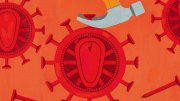In early 1995, a hemophiliac walked into the clinic of physician-immunobiologist Bruce Walker and announced something astonishing: he’d been infected with HIV during a blood transfusion in 1978, had never taken any anti-HIV medications, and yet had never developed AIDS. Walker tested him and found no signs of the virus itself, only a robust immune response to it, confirming that the man was infected. In fact, Walker recalls, it was the most vigorous immune response he’d ever seen.
Walker discovered that the man was one of a small number of HIV-infected persons (one-third of 1 percent of all carriers) who remain healthy, without anti-HIV medications, even decades after infection. And he began to wonder: could understanding how these “elite controllers” beat the virus on their own lead to a functional cure for the 37 million people who are infected worldwide?
The human immunodeficiency virus is a tough opponent. Different strains can vary genetically as much as 40 percent from each other and mutate rapidly. The virus not only attacks and cripples the immune system itself, undermining the body’s own ability to fight back, but is also surrounded, Walker explains, by “a heavy sugar coating that blocks the access of immune-system-generated antibodies, which normally would clear this kind of infection.”
But perhaps the biggest challenge is that HIV integrates into DNA, becoming part of a host cell’s genome. Here it lies silently, unaffected by the front-line medicines—antiretroviral therapy (ART) now used to control the infection—that have made HIV a treatable but not curable disease. Even years of treatment with the most potent ART cocktails won’t eradicate latently infected cells. (These cells do die eventually, but so slowly that even after more than 40 years of treatment, only half will be gone.) As a result, if ART is withdrawn, activation of a single one of those infected cells turns the virus on and can lead to a renewed, full-blown infection within weeks. In stark contrast, Walker says, some elite controllers may be on the verge of eradicating their HIV altogether, because even the most sensitive tests now available fail to detect the virus in their systems.
Walker, now Ragon professor of medicine and director of the Ragon Institute of Massachusetts General Hospital, MIT, and Harvard, has studied 1,500 of these HIV controllers for more than a decade. With initial support from entrepreneur Mark Schwartz ’76 and his wife, Lisa, and continued funding from the Gates Foundation, he discovered that these patients’ immune systems are able to keep the virus in check effectively in much the same way the chickenpox virus (VZV) is controlled: the virus remains alive but dormant. (Shingles may develop if the immune system stops controlling VZV.) In the case of HIV, this control is associated with targeting the most conserved (least mutable) part of the virus, the bullet-shaped core known as the capsid, rather than the rapidly mutating sugar coating that surrounds it. But that alone did not explain controllers’ resistance to the virus, because some patients whose immune systems target the viral capsid became sick anyway.
Walker then tried a new tack, aided by computational biologist Arup Chakraborty, of the Harvard-MIT Program in Health Sciences and Technology (HST). They applied an analytical technique sometimes used in the stock market: “If one stock goes up or down, how does that affect other stocks? We did a similar analysis with HIV,” Walker explains: “If one mutation occurs, how does that affect the ability of other mutations to happen?”
They looked at the amino acids—the building blocks of the proteins that make up the virus—to see how the mutation of any one amino acid affected the ability of others in the chain to mutate. The result was striking. Among the thousands of sequences generated from patients’ viruses, they found certain amino acids that could readily mutate individually, but were never seen mutated at the same time in a single virus. “That didn’t make sense,” Walker says, “until we looked at the three-dimensional structure of the protein.” A string of amino acids forms loops when different amino acids interact, creating structures as the protein folds. “It turned out that these amino acids lay at the interface regions where the protein folded back on itself,” and were therefore structurally important to its survival.
The researchers then applied social-network theory to better understand how these structures were created and maintained. In any social network, Walker explains, some people are more connected than others, and the same is true of amino acids. Although all have the same backbone structure, their chemical side chains range from small, as in glycine, to enormous, as in tryptophan. That means, Walker says, “that the tryptophan has the ability to make lots of connections, thereby playing a bigger role in the network that forms when a protein folds.” A pair of talented HST program physician-scientist postdocs in Walker’s lab and at the Broad Institute, Gaurav Gaiha and Elizabeth Rossin, created a method to determine how networked each HIV amino acid is, and were able to show that elite controllers’ immune systems target the most networked amino acids in the highly conserved viral core. As a result, when the virus mutates to evade this targeted immune pressure, it falls apart: the acids that mutate are critical to its structure, and thus its survival.
Walker, Gaiha, and Rossin are now applying this knowledge to developing a vaccine that can induce natural immune control of HIV in persons already infected and protect against HIV transmission to those not yet infected. Walker believes the early stages of the infection may hold the key to elite controllers’ unusual immune response. The first sign of illness typically appears about two to four weeks after the initial infection, when patients develop symptoms that resemble flu or mononucleosis; blood sampled during this period contains as many as 10 million viral particles per milliliter of plasma, and reduced numbers of immune cells. He is therefore studying the effect of rapid, early therapeutic interventions—before the initial flu-like stage—among a small high-risk patient population, to test whether this will allow the natural immune response to beat the virus, perhaps in combination with a vaccine that trains the immune system to target its most vulnerable parts.
Eventually, he hopes, it will be possible retrain the immune response of anyone infected with HIV—to make elite controllers of them all.








